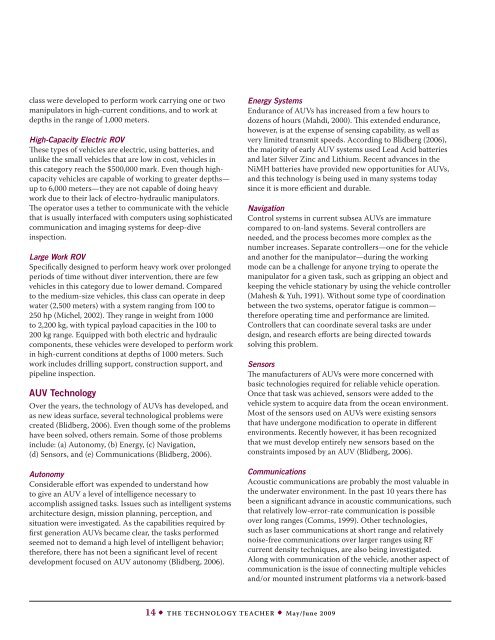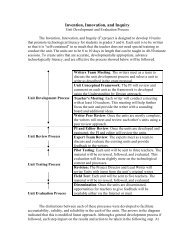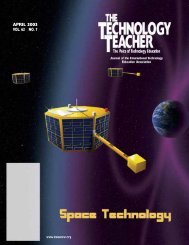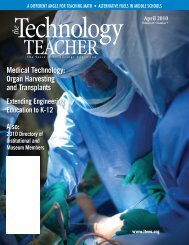May/June 2009 - International Technology and Engineering ...
May/June 2009 - International Technology and Engineering ...
May/June 2009 - International Technology and Engineering ...
You also want an ePaper? Increase the reach of your titles
YUMPU automatically turns print PDFs into web optimized ePapers that Google loves.
class were developed to perform work carrying one or two<br />
manipulators in high-current conditions, <strong>and</strong> to work at<br />
depths in the range of 1,000 meters.<br />
High-Capacity Electric ROV<br />
These types of vehicles are electric, using batteries, <strong>and</strong><br />
unlike the small vehicles that are low in cost, vehicles in<br />
this category reach the $500,000 mark. Even though highcapacity<br />
vehicles are capable of working to greater depths—<br />
up to 6,000 meters—they are not capable of doing heavy<br />
work due to their lack of electro-hydraulic manipulators.<br />
The operator uses a tether to communicate with the vehicle<br />
that is usually interfaced with computers using sophisticated<br />
communication <strong>and</strong> imaging systems for deep-dive<br />
inspection.<br />
Large Work ROV<br />
Specifically designed to perform heavy work over prolonged<br />
periods of time without diver intervention, there are few<br />
vehicles in this category due to lower dem<strong>and</strong>. Compared<br />
to the medium-size vehicles, this class can operate in deep<br />
water (2,500 meters) with a system ranging from 100 to<br />
250 hp (Michel, 2002). They range in weight from 1000<br />
to 2,200 kg, with typical payload capacities in the 100 to<br />
200 kg range. Equipped with both electric <strong>and</strong> hydraulic<br />
components, these vehicles were developed to perform work<br />
in high-current conditions at depths of 1000 meters. Such<br />
work includes drilling support, construction support, <strong>and</strong><br />
pipeline inspection.<br />
AUV <strong>Technology</strong><br />
Over the years, the technology of AUVs has developed, <strong>and</strong><br />
as new ideas surface, several technological problems were<br />
created (Blidberg, 2006). Even though some of the problems<br />
have been solved, others remain. Some of those problems<br />
include: (a) Autonomy, (b) Energy, (c) Navigation,<br />
(d) Sensors, <strong>and</strong> (e) Communications (Blidberg, 2006).<br />
Autonomy<br />
Considerable effort was expended to underst<strong>and</strong> how<br />
to give an AUV a level of intelligence necessary to<br />
accomplish assigned tasks. Issues such as intelligent systems<br />
architecture design, mission planning, perception, <strong>and</strong><br />
situation were investigated. As the capabilities required by<br />
first generation AUVs became clear, the tasks performed<br />
seemed not to dem<strong>and</strong> a high level of intelligent behavior;<br />
therefore, there has not been a significant level of recent<br />
development focused on AUV autonomy (Blidberg, 2006).<br />
Energy Systems<br />
Endurance of AUVs has increased from a few hours to<br />
dozens of hours (Mahdi, 2000). This extended endurance,<br />
however, is at the expense of sensing capability, as well as<br />
very limited transmit speeds. According to Blidberg (2006),<br />
the majority of early AUV systems used Lead Acid batteries<br />
<strong>and</strong> later Silver Zinc <strong>and</strong> Lithium. Recent advances in the<br />
NiMH batteries have provided new opportunities for AUVs,<br />
<strong>and</strong> this technology is being used in many systems today<br />
since it is more efficient <strong>and</strong> durable.<br />
Navigation<br />
Control systems in current subsea AUVs are immature<br />
compared to on-l<strong>and</strong> systems. Several controllers are<br />
needed, <strong>and</strong> the process becomes more complex as the<br />
number increases. Separate controllers—one for the vehicle<br />
<strong>and</strong> another for the manipulator—during the working<br />
mode can be a challenge for anyone trying to operate the<br />
manipulator for a given task, such as gripping an object <strong>and</strong><br />
keeping the vehicle stationary by using the vehicle controller<br />
(Mahesh & Yuh, 1991). Without some type of coordination<br />
between the two systems, operator fatigue is common—<br />
therefore operating time <strong>and</strong> performance are limited.<br />
Controllers that can coordinate several tasks are under<br />
design, <strong>and</strong> research efforts are being directed towards<br />
solving this problem.<br />
Sensors<br />
The manufacturers of AUVs were more concerned with<br />
basic technologies required for reliable vehicle operation.<br />
Once that task was achieved, sensors were added to the<br />
vehicle system to acquire data from the ocean environment.<br />
Most of the sensors used on AUVs were existing sensors<br />
that have undergone modification to operate in different<br />
environments. Recently however, it has been recognized<br />
that we must develop entirely new sensors based on the<br />
constraints imposed by an AUV (Blidberg, 2006).<br />
Communications<br />
Acoustic communications are probably the most valuable in<br />
the underwater environment. In the past 10 years there has<br />
been a significant advance in acoustic communications, such<br />
that relatively low-error-rate communication is possible<br />
over long ranges (Comms, 1999). Other technologies,<br />
such as laser communications at short range <strong>and</strong> relatively<br />
noise-free communications over larger ranges using RF<br />
current density techniques, are also being investigated.<br />
Along with communication of the vehicle, another aspect of<br />
communication is the issue of connecting multiple vehicles<br />
<strong>and</strong>/or mounted instrument platforms via a network-based<br />
14 • The <strong>Technology</strong> Teacher • <strong>May</strong>/<strong>June</strong> <strong>2009</strong>
















